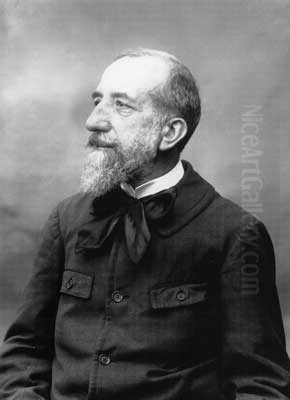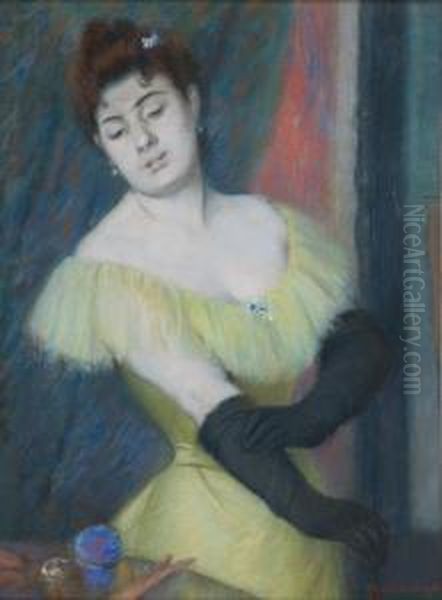
Federico Zandomeneghi stands as a fascinating figure in late 19th and early 20th-century European art. An Italian painter deeply rooted in the rich artistic heritage of Venice, he became an integral part of the revolutionary Impressionist movement in Paris. His life and work represent a unique confluence of Italian artistic sensibilities, particularly the Macchiaioli's emphasis on light and realism, and the groundbreaking techniques and modern subject matter of French Impressionism. Zandomeneghi carved a distinct niche for himself, celebrated for his vibrant palette, intimate portrayals of modern life, and particularly his sensitive depictions of women.
Venetian Beginnings and Artistic Heritage
Federico Zandomeneghi was born in Venice on June 2, 1841, into a family already distinguished in the arts. His grandfather, Luigi Zandomeneghi, and his father, Pietro Zandomeneghi, were both accomplished Neoclassical sculptors. Their legacy included significant works, such as contributions to the monument of the renowned Renaissance painter Titian in the Basilica di Santa Maria Gloriosa dei Frari in Venice. This environment undoubtedly fostered Federico's early inclination towards the arts, though he would ultimately pursue painting rather than sculpture.
His formal artistic education began at the Venice Academy of Fine Arts (Accademia di Belle Arti di Venezia). However, his studies were interrupted by the political turmoil of the time. In 1859, facing conscription into the army of the Austrian Empire, which then controlled Venice, the young Zandomeneghi chose to flee. This act reflected his patriotic support for the Risorgimento, the movement for Italian unification. He initially sought refuge in Milan, where he continued his artistic training, likely absorbing the influences of Lombard naturalism.
Florence and the Macchiaioli Influence
By 1862, Zandomeneghi had relocated to Florence, a vibrant center of artistic innovation in Italy at the time. It was here that he became closely associated with the Macchiaioli, a group of painters who were reacting against the staid academicism prevalent in Italian art institutions. The Macchiaioli, whose name derives from the Italian word 'macchia' (meaning patch or spot), advocated for painting outdoors (plein air) to capture the immediate effects of light and shadow, using bold patches of color and strong tonal contrasts.

This group, often considered the Italian precursors or counterparts to French Impressionism, included artists like Giovanni Fattori, Silvestro Lega, and Telemaco Signorini. Zandomeneghi formed a particularly close and lasting friendship with Signorini, maintaining correspondence with him even after leaving Italy. Another key figure in this circle was the critic and painter Diego Martelli, who became a champion of the group and later played a crucial role in encouraging Zandomeneghi's move to Paris. The Macchiaioli's emphasis on capturing reality directly and their experiments with light and color profoundly shaped Zandomeneghi's early development.
While in Florence, Zandomeneghi participated in the Macchiaioli's discussions at the Caffè Michelangiolo, a famous gathering spot for artists and intellectuals. His work during this period began to reflect the group's principles, moving towards a more naturalistic depiction of landscapes and everyday life, rendered with a freer application of paint and a heightened sensitivity to atmospheric effects. This Florentine period was crucial in laying the groundwork for his later engagement with Impressionism.
The Move to Paris: Embracing Impressionism
The year 1874 marked a pivotal turning point in Zandomeneghi's life and career. Encouraged by Diego Martelli, he moved to Paris, the undisputed capital of the avant-garde art world. The city was buzzing with the energy of the Impressionist movement, which had just held its first independent exhibition that same year. Zandomeneghi quickly immersed himself in this stimulating environment.
His arrival in Paris brought him into contact with the leading figures of Impressionism. He developed particularly strong bonds with Edgar Degas and Pierre-Auguste Renoir. Degas, known for his sharp observation and unconventional compositions, became a close friend and mentor figure. It was Degas who invited Zandomeneghi to participate in the Impressionist group exhibitions.
Zandomeneghi exhibited alongside the French Impressionists in four of their eight independent shows: in 1879, 1880, 1881, and the final exhibition in 1886. This participation solidified his position within the movement, even as an Italian expatriate. He became a familiar figure in the Parisian art scene, frequenting cafes like the Café de la Nouvelle Athènes, a hub for artists and writers including Édouard Manet, Degas, and Camille Pissarro, with whom Zandomeneghi also formed a close friendship. His colleagues affectionately nicknamed him "Zandò" or sometimes "Le Vénitien" (The Venetian), acknowledging his Italian origins.
Artistic Style: A Synthesis of Influences
Zandomeneghi's move to Paris precipitated a significant evolution in his artistic style. While he never entirely abandoned the solid drawing and compositional structure perhaps inherited from his Italian training and Macchiaioli experience, he fully embraced the Impressionist preoccupation with light, color, and contemporary subject matter. His palette brightened considerably, incorporating the vibrant hues favored by his French contemporaries.

His brushwork became looser and more visible, capturing the fleeting moments of modern life with energy and immediacy. He shared the Impressionists' interest in depicting scenes of leisure and entertainment – Parisians strolling in parks, attending the theatre, or relaxing in cafes. However, Zandomeneghi developed a particular focus on intimate interior scenes, often featuring women engaged in quiet, everyday activities.
The influence of Degas is often noted in Zandomeneghi's work, particularly in his compositions, which sometimes employ cropped perspectives and asymmetrical arrangements, and in his choice of subjects like dancers and women at their toilette. However, Zandomeneghi's approach was generally warmer and less detached than Degas's. The influence of Renoir can be seen in the sensuousness of his color and the gentle charm with which he often imbued his female figures. Despite these influences, Zandomeneghi maintained a distinct artistic personality, blending his Venetian feeling for color and a certain Tuscan grace with Parisian modernity.
Some sources mention his exploration of "divisionist techniques," likely referring to the broken brushwork and optical mixing of colors characteristic of Impressionism and Neo-Impressionism, rather than a strict adherence to the pointillist methods of Georges Seurat or Paul Signac. His paintings often feature a rich, textured surface built up with dense, deliberate strokes, creating a vibrant tapestry of color that retains a strong sense of form.
Favourite Themes: The Intimate World of Women
A defining characteristic of Zandomeneghi's oeuvre, especially during his Parisian years, is his focus on the female figure. He excelled at capturing women in moments of quiet introspection or domestic activity. Reading, writing letters, grooming, having tea, or simply lost in thought – these became recurrent themes in his work. He portrayed the modern Parisian woman with sensitivity and elegance, avoiding overt sentimentality while still conveying a sense of intimacy and psychological presence.
Works like La Lecture (Reading) exemplify this focus, depicting a woman absorbed in her book, rendered with delicate attention to the play of light on her form and surroundings. For Tea captures a moment of quiet sociability, showcasing his skill in handling interior light and rich textures. His depictions of women at their toilette, while perhaps echoing Degas, often possess a softer, more decorative quality.
He also painted scenes set in public spaces, such as At the Café de la Nouvelle Athènes, capturing the ambiance of Parisian social life. His depictions of dancers, like La Ballerina (The Dancer), show an elegance and grace that, while perhaps less dynamic than Degas's ballet scenes, possess their own distinct charm. Some analyses of works like La Ballerina note a stylistic affinity with the emotional intensity and expressive forms found in Post-Impressionist painters like Vincent van Gogh or Paul Gauguin, suggesting Zandomeneghi's awareness of artistic developments beyond Impressionism.
Other notable works that showcase his range include Sur l'herbe (On the Grass), reflecting the Impressionist interest in outdoor leisure, Les Deux Soeurs (The Two Sisters), an intimate double portrait, and Glove (often referred to as The Black Glove), focusing on a detail of modern fashion within a portrait context. Throughout these varied subjects, his commitment to vibrant color and capturing the nuances of contemporary life remained constant.
The Role of Paul Durand-Ruel
The trajectory of Zandomeneghi's career in Paris was significantly aided by his relationship with the prominent art dealer Paul Durand-Ruel. Durand-Ruel was a crucial supporter of the Impressionist movement, championing artists like Monet, Renoir, Pissarro, Degas, and Sisley through exhibitions and financial backing when they faced public hostility and critical dismissal.
Recognizing Zandomeneghi's talent and unique position, Durand-Ruel began to handle his work. He organized Zandomeneghi's first solo exhibition at his gallery in 1893. This was followed by further solo shows in 1897 and 1899. These exhibitions were instrumental in establishing Zandomeneghi's reputation and securing a market for his paintings, providing him with greater financial stability and recognition during the later part of his career. The support of such an influential dealer underscored Zandomeneghi's acceptance within the Parisian art establishment.
Later Years and Lasting Legacy
Federico Zandomeneghi remained in Paris for the rest of his life, continuing to paint prolifically. He witnessed the evolution of Impressionism and the rise of Post-Impressionism and Fauvism, though his own style remained largely consistent with his mature Impressionist approach developed in the 1880s and 1890s. He continued to refine his intimate portrayals of women and Parisian life, characterized by their luminous color and delicate execution.
He passed away in Paris on December 31, 1917, at the age of 76. By the time of his death, he was a respected figure, acknowledged for his contribution to Impressionism and his unique role as an Italian artist who successfully integrated into the French avant-garde. His legacy lies in his ability to synthesize diverse influences – his Venetian heritage, the realism of the Macchiaioli, and the innovations of French Impressionism – into a personal and appealing style.
Zandomeneghi's work serves as an important bridge between 19th-century Italian art and the broader currents of European modernism. He demonstrated that the Impressionist exploration of light, color, and modern life was not solely a French phenomenon, but part of a wider artistic transformation occurring across Europe. His paintings remain admired for their charm, technical skill, and sensitive portrayal of an era.
Market Presence and Museum Collections
Today, Federico Zandomeneghi's works are sought after by collectors and are represented in major museum collections worldwide. His paintings occasionally appear at international auctions, sometimes commanding significant prices. A notable example is the sale of his painting La Lecture at Christie's in New York in May 2007, which achieved a remarkable price of $5.02 million, highlighting the high regard in which his work is held. Other works, like Colloquio al tavolo (Conversation at the Table), have also surfaced in the art market, often passing through private collections.
His paintings are housed in prestigious public institutions, ensuring his art remains accessible to the public. Important examples can be found in the Galleria d'Arte Moderna in Barcelona, Spain, and in Italy at the Palazzo Te in Mantua. In France, the country where he spent the most productive part of his career, his work is fittingly represented in the collection of the Musée d'Orsay in Paris, the world's foremost museum dedicated to Impressionist and Post-Impressionist art.
Conclusion
Federico Zandomeneghi occupies a unique and significant place in the history of late 19th-century art. Born into the artistic traditions of Venice and shaped by the realism of the Florentine Macchiaioli, he fully embraced the revolutionary spirit of Impressionism upon moving to Paris. His close association with Degas, Renoir, and Pissarro, and his participation in the Impressionist exhibitions, mark him as a key figure of the movement, albeit one with a distinct Italian sensibility. Celebrated for his vibrant color, intimate scenes of modern life, and especially his elegant depictions of women, Zandomeneghi created a body of work that continues to charm and engage viewers. His life and art exemplify the rich cross-cultural exchanges that defined European modernism, leaving behind a legacy that bridges Italian artistic heritage and French avant-garde innovation.